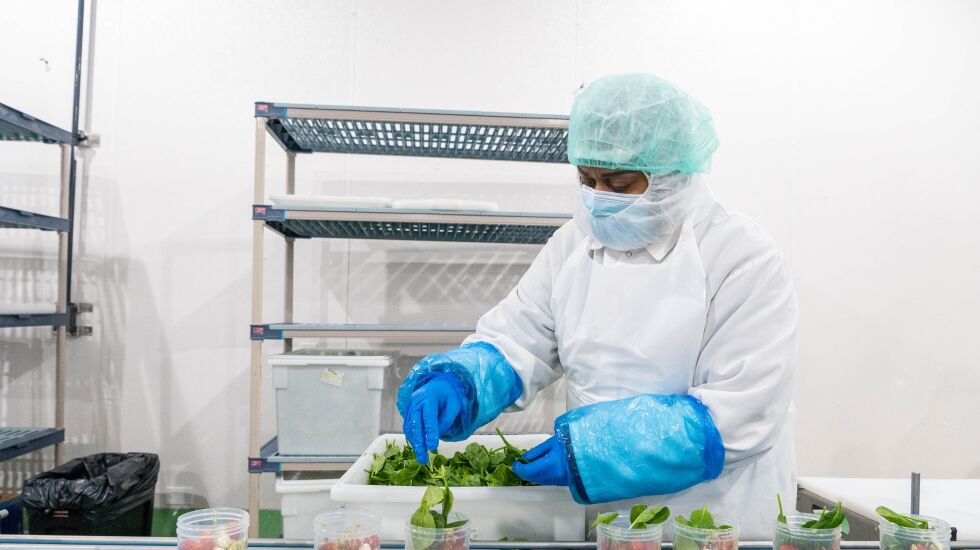
Draped head to toe, from hairnet to shoe covers, Terri Burnett stands alongside dozens of similarly-clad workers in a 37 degree room, grabbing handfuls of dark green spinach from a white trough and poking them into round clear plastic jars of pesto pasta hurrying past her on a conveyor line.
What’s her job like?
“It’s fun,” she said.
“Fun?” How can that be?
“They let you just do you. They let you just be calm,” said Burnett, 41. “There’s no rush. They let you work at a pace.”
Nor is she uncomfortable.
“I’m actually not cold,” she said, noting that when she first arrived, three years ago, she bundled up in layers. “You need two pair of pants on when you first start, or you won’t survive,” she recalled. But that passed, and now she gets by with a hoodie and small knit gloves.
We’re on the South Side, in the assembly room at Farmer’s Fridge, a company that produces fresh salads — and meal bowls and desserts like chocolate chia raspberry pudding — nestles them into clear plastic jars and dispatches them across the country.
Readers might recall I first tried their Harvest Salad during a few hours of idleness at Dallas Fort Worth International Airport, noticed that it’s a Chicago endeavor, talked to founder, Luke Saunders and was intrigued by the fact that the salads, with their fleeting shelf life are not produced at satellite plants around the country, but are all created in Chicago, at a single 100,000-square-foot production facility.
Even though Midway airport is literally across 54th Street, the perishables are not put on airplanes but trucked overland to 20 markets in Texas, California and the Northeast: 700 locations, not just their distinctive vending machines — there’s just off the great hall at Union Station — but stores like Target and Jewel-Osco.
How could you turn aside an invitation to visit? (All right, they didn’t ask me, I invited myself. But they said yes). Because if you don’t go, you never realize, for instance, the important role that washing plays. Because salads are not heated, they are party buses for pathogens such as salmonella.
“Produce is grown outside,” Saunders said. “Dirt. Birds. Squirrels. The whole deal with scaling fresh food is you have to figure out how to clean it. Every single ingredient goes through the Kronen. Nothing is allowed in without being washed.”
“The Kronen” is the stainless steel German wet decontamination and washing system, a piece of modern food technology that mocks the flimsy plastic salad spinner I use to give my luncheon salad a quick rinse.

Here, everything goes into a large trough-like industrial washer for an agitated antimicrobial bath. Farmer’s Fridge even washed hot sauce packets tucked inside their Burrito Bowl jars until they convinced their supplier to do it for them before shipping.
But I’m jumping ahead. Before ingredients can be washed, they have to get here. In February, they’re coming from the West Coast, but in season, 25 percent of the 150 ingredients that go into Farmer’s Fridge products come from within 250 miles of Chicago.
“In the summer, kale from Michigan is cheaper and higher quality than kale from California,” Saunders said. “We’re actually in a great region. Farmland is cheap enough that the California growers compete with the Midwest growers. If you go to New York , produce is more expensive because they don’t have the competition.”

Once washed, the lettuce and tomatoes, corn and the rest get cooked, sliced, diced or, in the case of apples, soaked in brine to resist turning brown. Fresh salad dressing is mixed, guacamole churned from scratch, then covered in pico de gallo to keep the air from it.
Another national operation might off-load the process — buy the lettuce already cut, for instance. But that sacrifices freshness.
“We built this whole operation around cutting the tomato in the morning that we’re making the salad,” Saunders said. “That’s a huge part of the challenge. But also why the food is so much better and fresher. Build the business around a product rather than building the product around a business.”

Then there is the thorny logistical challenge of deciding how much of what to make and where it should be trucked.
“We made all this food without knowing where it’s going,” Saunders said. “The whole demand-planning system is built to be flexible. We’re running that as a demand-planning exercise starting three months out, trying to predict the future of what we’re going to sell.’
So the weather in Dallas or the state of Southwest Airlines computer dictates how many onions are being ordered — TSA reports are regularly checked. The Monday after the Super Bowl is, unsurprisingly, their busiest time of year.
“The day after the Super Bowl is typically our best day of the year because everybody eats a bunch of junk food,” Saunders said, then reach the next day for the healthier options Farmer’s Fridge offers.
Farmer’s Fridge has 70 full-time drivers whose role should not be ignored. They start picking up boxed jars every day about 6 a.m. Delivery can be tricky.
“Every location they go into is different,” Saunders said. “You’re going into an airport. You’re going into an office building. Trying to get into a university in the middle night. All those challenges they deal with.”
Drivers confront everything from filled loading docks to their trucks being stolen while they’re inside filling vending machines.
Someone once used a stolen code to clean out a Farmer’s Fridge machine, and Saunders’ reaction was both surprising and a touching tribute to the enthusiasm of the company founder.
“The first time someone stole food from us, I was thrilled,” he remembered. “Everybody was really mad, but I was like, ‘That’s great. If someone is willing to commit a crime to get our food, I think we’ve accomplished something.’”







